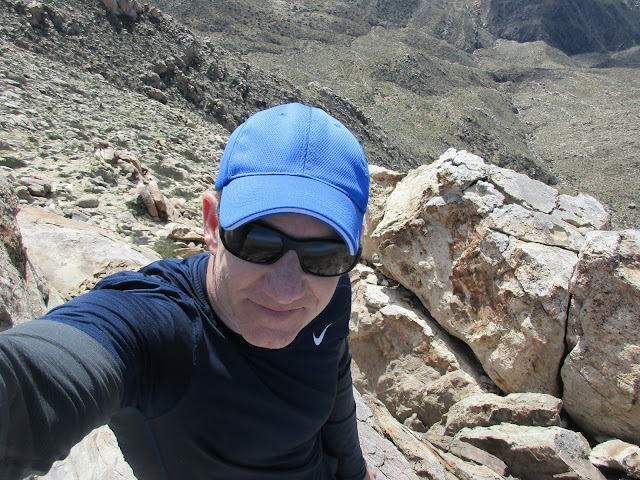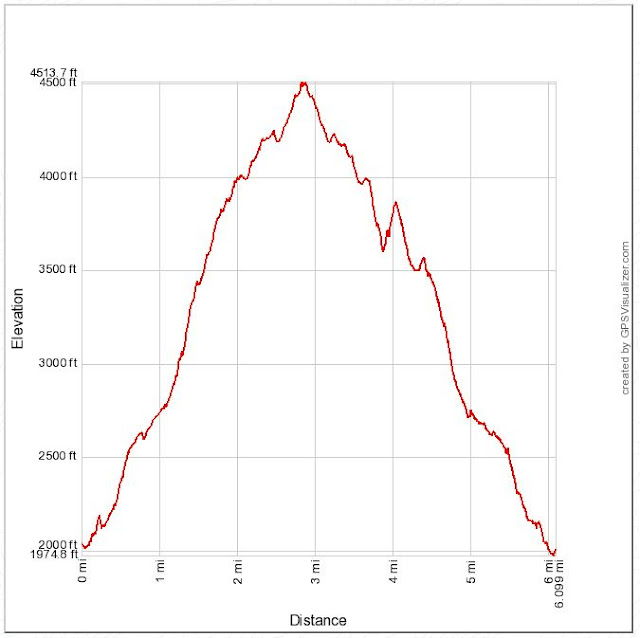Distance: 6 miles round trip cross country
Summit Elevation: 4512'
Prominence: 1272'
Elevation Gain: 2933'
Elevation Gain (in Empire State Buildings): 2.34
Round trip time: 5 hours 30 minutes
Recommended water: 88 oz.
Parking/Fees: Free at Mortero Palms
Difficulty: Moderate
The third and final goal of the day was Jacumba Mountain, #40 on the SDC list and #74 on the Desert Peaks list. There is a shorter route on the south side that seems to have gained favor recently, but I was already close to the northern trailhead at Mortero Palms and I needed the extra training. Note: time and elevation gain are higher than they should be due to mistakes I made on the way back. My first trip down Mortero Canyon road was in a sedan and I had to stop well before the train tracks because I could not make it over a large rock. This time, the 4Runner was able to cruise over the worst spots. Campers had several tents set up at Dos Cabezas as I drove by.
At the Mortero Palms trailhead, a group of six was gearing up for a hike to Goat Canyon Trestle. They asked me if I had been to the trestle and where the trail started. I told them I had been there, but from a different starting point. I gave them a few tips on finding the use trail once they got to Goat Canyon, but was concerned that none of them had a map or GPS. They looked young and fit, but unprepared. They started ahead of me into the south canyon, the way I was headed, instead of Palm Canyon. They were about 100 yards ahead of me, and started climbing in the direction of Palm Canyon, so I thought maybe they would be OK. The boulder scramble begins immediately with a mix of class 2 and class 3. I found the path of least resistance was usually left of center on the way up. The climb to the top was enjoyable and got my blood pumping. I exited the canyon onto a flat plain with several huge piles of rocks rising from the earth on both sides. I could see Jacumba at the top of a steep canyon on the left, while the ridge line formed a north-south wall. As I crossed the plain, one of the boulder piles caught my attention to the south. I could see two large caves in the formation and made a mental note to check them out on the way back.
Instead of tackling the most direct canyon, I picked a spot on the ridge line and started in that direction. It was a long slog of steep class 1 to the ridge line. I took a break when I gained the ridge, knowing there were going to be major bumps and false summits along the way. I took aim at the first bump and plodded upward. From there, I could not see Jacumba, so I headed for the next. I skirted the flank of the highest bumps and found remnants of a use trail along the last mile. When I got close enough to see the summit, I spotted a crow or raven perched on the wooden pole jutting up there. I didn't take that as a good omen. It only flew off when I was just below the block. The Jacumba summit block was low class 2, and has a neat drop off on the west side. There was a benchmark and reference mark on the main block along with an ammo box containing several registers. I relaxed and took in the expansive views in all directions. After all summit rituals were complete, I started back with confidence I could descend quickly.
It turned out I had too much confidence as I overshot the ridge line and started down a gully in the wrong canyon. As the landmarks started looking alien, I checked my GPS and tried to correct my course. This involved climbing back out of the gully and taking a side hill path back to the point I where I gained the ridge. I should have just descended, then headed back to the descent canyon. With extra effort, I got back on my original line, but gave up on the idea of exploring the caves I noted on the way up. I didn't have the energy for the cave exploration, but it might be worth a future trip. I was glad to get back into the descent canyon and scramble down to the trailhead. There I saw four of the six hikers I met at the start, waiting for the other two to return. They had gotten lost and abandoned their trip to the trestle, returning down Palm Canyon without even getting a look at it. Like me, they had been roughed up a bit, but were no worse for wear. Their other two companions had continued on, but they did not know if they had been successful. Jacumba was more of a challenge than I expected and a fun desert peak.





































































